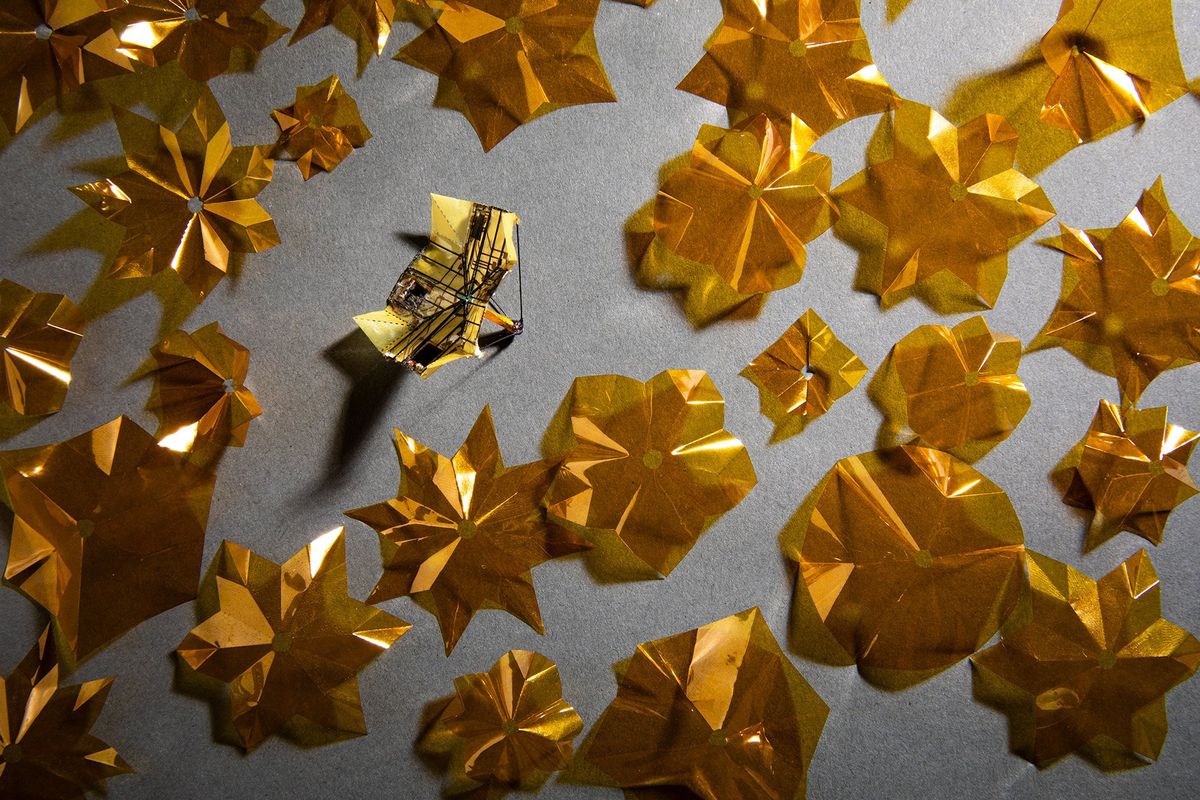Video Friday is your weekly selection of awesome robotics videos, collected by your friends at IEEE Spectrum robotics. We also post a weekly calendar of upcoming robotics events for the next few months. Please send us your events for inclusion.
IROS 2023: 1–5 October 2023, DETROIT
CLAWAR 2023: 2–4 October 2023, FLORIANOPOLIS, BRAZIL
ROSCon 2023: 18–20 October 2023, NEW ORLEANS
Humanoids 2023: 12–14 December 2023, AUSTIN, TEXAS
Cybathlon Challenges: 2 February 2024, ZURICH
Enjoy today’s videos!
Researchers at the University of Washington have developed small robotic devices that can change how they move through the air by “snapping” into a folded position during their descent. When these “microfliers” are dropped from a drone, they use a Miura-ori origami fold to switch from tumbling and dispersing outward through the air to dropping straight to the ground.
And you can make your own! The origami part, anyway:
[ Science Robotics ] via [ UW ]
Thanks, Sarah!
A central question in robotics is how to design a control system for an agile, mobile robot. This paper studies this question systematically, focusing on a challenging setting: autonomous drone racing. We show that a neural network controller trained with reinforcement learning (RL) outperforms optimal control (OC) methods in this setting. Our findings allow us to push an agile drone to its maximum performance, achieving a peak acceleration greater than 12 g and a peak velocity of 108 km/h.
Also, please see our feature story on a related topic.
[ Science Robotics ]
Ascento has a fresh US $4.3 million in funding to develop its cute two-wheeled robot for less-cute security applications.
[ Ascento ]
Thanks, Miguel!
The evolution of Roomba is here. Introducing three new robots, with three new powerful ways to clean. For over 30 years, we have been on a mission to build robots that help people to do more. Now, we are answering the call from consumers to expand our robot lineup to include more 2-in-1 robot vacuum and mop options.
[ iRobot ]
As the beginning of 2023 Weekly KIMLAB, we want to introduce PAPRAS, Plug-And-Play Robotic Arm System. A series of PAPRAS applications will be posted in coming weeks. If you are interested in details of PAPRAS, please check our paper.
Gerardo Bledt was the Head of our Locomotion and Controls Team at Apptronik. He tragically passed away this summer. He was a friend, colleague, and force of nature. He was a maestro with robots, and showed all of us what was possible. We dedicate Apollo and our work to Gerardo.
[ Apptronik ]
This robot plays my kind of Jenga.
This teleoperated robot was built by Lingkang Zhang, who tells us that it was inspired by Sanctuary AI’s robot.
[ HRC Model 4 ]
Thanks, Lingkang!
Soft universal grippers are advantageous to safely grasp a wide variety of objects. However, due to their soft material, these grippers have limited lifetimes, especially when operating in unstructured and unfamiliar environments. Our self-healing universal gripper (SHUG) can grasp various objects and recover from substantial realistic damages autonomously. It integrates damage detection, heat-assisted healing, and healing evaluation. Notably, unlike other universal grippers, the entire SHUG can be fully reprocessed and recycled.
Thanks Bram!
How would the movie Barbie look like with robots?
[ Misty ]
Zoox is so classy that if you get in during the day and get out at night, it’ll apparently give you a free jean jacket.
[ Zoox ]
X30, the next generation of industrial inspection quadruped robot is on its way. It is now moving and climbing faster, and it has stronger adaptability to adverse environments with advanced add-ons.
[ DeepRobotics ]
Join us on an incredible journey with Alma, a cutting-edge robot with the potential to revolutionize the lives of people with disabilities. This short documentary takes you behind the scenes of our team’s preparation for the Cybathlon challenge, a unique competition that brings together robotics and human ingenuity to solve real-world challenges.
[ Cybathlon ]
NASA’s Moon rover prototype completed software tests. The VIPER mission is managed by NASA’s Ames Research Center in California’s Silicon Valley and is scheduled to be delivered to Mons Mouton near the South Pole of the Moon in late 2024 by Astrobotic’s Griffin lander as part of the Commercial Lunar Payload Services initiative. VIPER will inform future Artemis landing sites by helping to characterize the lunar environment and help determine locations where water and other resources could be harvested to sustain humans over extended stays.
[ NASA ]
We are excited to announce Husky Observer, a fully integrated system that enables robotics developers to accelerate inspection solutions. Built on top of the versatile Husky platform, this new configuration will enable robotics developers to build their inspection solutions and fast track their system development.
[ Clearpath ]
Land mines and other unexploded ordnance from wars past and present maim or kill thousands of civilians in dozens of nations every year. Finding and disarming them is a slow, dangerous process. Researchers from the Columbia Climate School’s Lamont-Doherty Earth Observatory and other institutions are trying to harness drones, geophysics and artificial intelligence to make the process faster and safer.
[ Columbia ]
Drones are being used by responders in the terrible Morocco earthquake. This 5 minute describes the 5 ways in which drones are typically used in earthquake response—and 4 ways that they aren’t.
[ CRASAR ]
Evan Ackerman is a senior editor at IEEE Spectrum. Since 2007, he has written over 6,000 articles on robotics and technology. He has a degree in Martian geology and is excellent at playing bagpipes.



